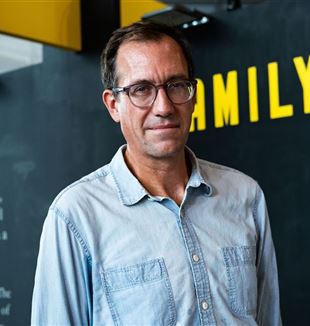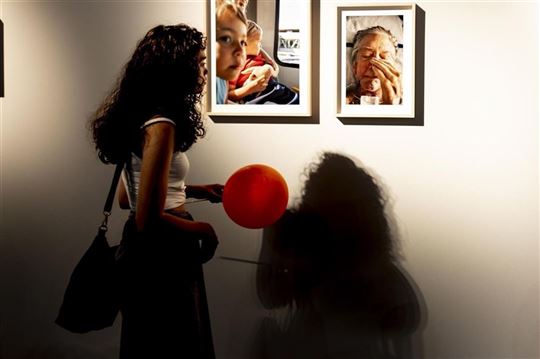
Gus Powell: "I’m still on the journey"
The New York-based photographer, the author of the images shown at the Meeting's "Family Car Trouble" exhibition, recounts his encounter with people in Rimini. Translated from the September issue of Tracce.I met Gus Powell in 2019 thanks to his book, Family Car Trouble. Three years later, I have curated the exhibition based on that volume for the Rimini Meeting. He was at the Meeting for a week, first setting up the exhibition and then giving tours. He says, "Family Car Trouble is the story of a road trip. A journey during which the only aspiration was, simply, to get the whole family through the day." The main characters are his wife, two daughters, his sick father, and Jimmy, a 1993 Volvo Polar. Daily life. The energy of childhood and the poignancy of seeing his father’s life slowly fade away. "The Meeting was an overwhelming experience. From the point of view of the amount of visitors, without a doubt. But beyond the numbers, I was struck by the quality of the public's response," he says on his return to the United States. "I surprise myself in thinking of new ways to talk about my photos, even though the exhibition is over. Fortunately, I have my daughters to keep me grounded. When Maude, my youngest, heard that everyone was stopping me to ask me questions, she said in a grimacing voice, ‘Yes, because you are so open and kindeee....’ They tease me, and they do well."
Tell me about your days in Rimini.
The evening before, I felt a bit like Boriska, the young man in Tarkovsky's Andrei Rublëv who builds the bell for the Duke. He is on edge until he tries it on: he does not know if it will really ring. But I think that Family Car Trouble sounded well at the Meeting.
Why do you say that?
The goal of this series of images was to spark discussion. And I had hundreds of conversations with people who came to thank me or people who did not understand and asked me questions. So many people, I feel, took something home with them. The visitors collaborated to the success of the exhibition, as did the wonderful volunteers who helped me set it up and the guides who presented it with me.
Why do you say the visitors "collaborated"?
These photographs represent moments in my family's life, but they are not meant as a diary to be kept in a drawer. Working first on the book and then on the exhibition, I chose the images that would best communicate to people who know nothing about my life. And these people started coming to us and telling us what they were feeling, and so many people wanted to tell us their stories. We saw some come out moved to tears. But I have no doubt that none of those who left crying were doing so because of my father's death. It is as if the exhibition gave them access to a specific place of memory and allowed them to relive, in public, certain feelings. And I am also quite convinced that, among those most affected, the majority had not experienced the death of a parent. In that sense I say they cooperated: if you tell your story to a rock, the story goes nowhere. A story needs to be heard and shared.
You said some people did not understand....
Yes, but they asked. I teach and I know how difficult it is to elicit questions. There was a moment when, within a short period of time, three boys between the ages of 19 and 23 approached me and asked why there were the three photographs of rain on the windshield. And, to me, it is quite obvious that – after the image of my father in the coffin- those pictures represent tears and grief. But males of that age find it easier to talk about cars. Nevertheless…
And yet?
When I was accompanying visitors to the exhibition, my favorite passage was that: after the image of my father's death, come the pictures of the rain. That was the moment when I saw people nodding. It is a poetic idea, but also a very real, everyday situation. When we park our car, we turn it off and stay there, without going out. It is us and our consciousness. These are moments of meditation. Sometimes of pain. It is a situation that I think has happened to everyone. You are there and you say to yourself, "What now?"
What encounters have struck you the most?
One day a lady came in, a grandmother. She had blue eyes and white hair. She had not followed my guided tour and wanted to come and tell me what she saw in my pictures. She was the one who guided me. And she had understood everything. Everything. You find a person who has much more experience than you and who reads your work and understands it perfectly. It was a gift. On another occasion, however, an 11-year-old boy came in and started talking to me about the picture that ends the exhibition, the one with my daughter opening her arms, as if opening up to the future. I could tell he wanted to practice his rudimentary English but, at the same time, he was really talking about that picture. How tender.
Have you learned something new about your work?
When you finish a project, you usually cannot take it anymore. You leave it behind and move on. The book came out in 2019, and by then I could not even remember the sequence of images very well anymore. But as I kept talking and answering questions, I realized that I am still processing that period of my life. I do not know how many times I went around the exhibit and I felt like I was in Groundhog Day, the movie with Bill Murray: I was repeating the same things over and over, but each time there was a different face to talk to. I had never been able to look at my images in this way before. And the fact that I was able to publish work on this subject does not mean that my pain has gone away. It is something that I still carry in me. It had been years since I had heard my father’s name said so many times: "We put Peter's picture like this...," or "Let's start with Peter...." I was moved to hear him mentioned again.
What do you think about the Meeting? In inviting you, I had explained what it was, but I had not done so in detail....
Yes, it was clear to me that I would meet people with a religious background. But I did not really know what to expect.
I thought your Italian friends would have already told you about what CL was.
Yes, when I said I was going to the Rimini Meeting many people's eyes lit up. They are people from the left, who often consider your movement to be at the polar opposite. But Giulia Zorzi, my gallerist, was convinced that it was still a great opportunity to make my work known and shared.
When you arrived in Rimini, what did you see?
In the United States, such an event, where the driving force is membership in a Christian group, in my mind – which is only mine, but it's the only thing I can start from – would have been something with a much more heated tone, even from the point of view of aesthetic expression: t-shirts with "Jesus Saves" written on them or large crosses everywhere... Ultimately, it is understandable, like when you go to the stadium. What you wear serves to make you feel close to those who are like you. It is natural. In contrast, in Rimini, both young people and priests did not show their religious position through their appearance. When I had a layover at the Paris airport on my way back to New York, I found myself in a place similar to the Rimini Meeting, and the people I was seeing were no different from those I saw at the Meeting. I had to ask myself what kind of connection there is among people at the Meeting.
What answer did you give yourself?
You can tell that it is not something dogmatic or reductive. It is something more sophisticated and subtle. Perhaps one way to put it is precisely the title of this Meeting: a passion for the human heart. Also the fact that everything was being talked about: science, religion, politics, economics, art... It was a real surprise. And when I asked the young people what was the aspect of the Meeting they loved the most, they replied: running into friends by chance. Seeing people you have not seen in years. Sitting and drinking and chatting at the end of the day. Beyond the exhibitions and lectures, the most interesting thing is meeting people.
And about Fr. Giussani, what did you discover about him?
Every now and then, in some discussion, his name would come up. On one occasion, I was talking to a person and Chiara, one of the guides, was with me who was translating. Before she left, the woman thanked me by saying something like, "Thank you for helping us to see reality" or "to live reality." And Chiara said to me, "That's a very CL phrase...." Over the next few days I tried to figure out what she meant and realized that it is a kind of mantra, taken from Fr. Giussani's first book, The Religious Sense.
Read also - "God became man. To say that is already enough"
"Living the real intensely..."
Exactly. And it is a phrase which I identify with a lot. The photographer is intensely observing reality and simultaneously trying to see himself within what he is looking at. That is a fundamental aspect of Family Car Trouble. And it is nice that people have been able to see, in my work, something that connects it with the religious teaching they have received or, at least, with a part of it. Then, for me, the relationship with reality is completely subjective, so I am not sure if it is really the same thing that Giussani means. But it was a point of encounter between people, me and my work. The Meeting gave me a copy of The Religious Sense. I will read it and we will talk about it.